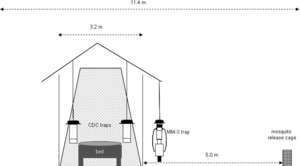
Problem being addressed[edit | edit source]
Many mosquitos in tropical and subtropical regions carry protists that cause malaria in humans. The mosquitos are abundant in these regions because of the optimal climate. Hence, there is a need to control mosquitos' habitat to prevent malaria spread.
Detailed description of the solution[edit | edit source]
Since mosquitos are attracted to light sources as well as CO2, they are drawn in to the CO2-baited CDC light traps. Reducing the number of mosquitos near houses and villages will help prevent bites that could cause malaria.
Designed by[edit | edit source]
- Designed by: W. Daniel Sudia and Roy Chamberlain in 1960
When and where it was tested/implemented[edit | edit source]
Tested in Kenya (Mwea division in Kirinyaga District), Republic of Korea (Paju County, Kyonggi Province), and Taiwan
References[edit | edit source]
Peer-reviewed publication[edit | edit source]
- Smallegange, Renate C., et al. (2010.) Sugar-fermenting yeast as an organic source of carbon dioxide to attract the malaria mosquito Anopheles gambiae. Malar J 9: 292. Link Available here
- Chen, Y-C et al. (2011.) Comparison of the efficacy of CO2-baited and unbaited light traps, gravid traps, backpack aspirators, and sweep net collections for sampling mosquitoes infected with Japanese encephalitis virus. Journal of vector ecology journal of the Society for Vector Ecology 36.1: 68-74.
- Muturi, Ephantus J., et al. (2007.) Evaluation of four sampling techniques for surveillance of Culex quinquefasciatus (Diptera: Culicidae) and other mosquitoes in African rice agroecosystems." Journal of medical entomology 44.3: 503-508. Link Available here
- Burkett, Douglas A., et al. (2002.) Late season commercial mosquito trap and host seeking activity evaluation against mosquitoes in a malarious area of the Republic of Korea. The Korean journal of parasitology 40.1: 45-54. Link Available here